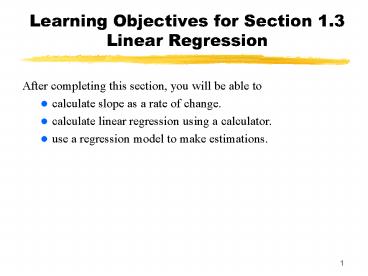Learning Objectives for Section 1.3 Linear Regression - PowerPoint PPT Presentation
1 / 18
Title:
Learning Objectives for Section 1.3 Linear Regression
Description:
Learning Objectives for Section 1.3 Linear Regression After completing this section, you will be able to calculate slope as a rate of change. calculate linear ... – PowerPoint PPT presentation
Number of Views:159
Avg rating:3.0/5.0
Title: Learning Objectives for Section 1.3 Linear Regression
1
Learning Objectives for Section 1.3 Linear
Regression
- After completing this section, you will be able
to - calculate slope as a rate of change.
- calculate linear regression using a calculator.
- use a regression model to make estimations.
2
Mathematical Modeling
- MATHEMATICAL MODELING is the process of using
mathematics to solve real-world problems. This
process can be broken down into three steps - Construct the mathematical model, a problem whose
solution will provide information about the
real-world problem. - Solve the mathematical model.
- Interpret the solution to the mathematical model
in terms of the original real-world problem. - In this section we will discuss one of the
simplest mathematical models a linear equation.
3
Slope as a Rate of Change
If x and y are related by the equation y mx
b, where m and b are constants with m not equal
to zero, then x and y are linearly related. If
(x1, y1) and (x2, y2) are two distinct points on
this line, then the slope of the line is
This ratio is called the RATE OF CHANGE of y with
respect to x.
4
Slope as a Rate of Change
Since the slope of a line is unique, the rate of
change of two linearly related variables is
constant. Some examples of familiar rates of
change are miles per hour and revolutions per
minute.
5
Example 1 Rate of Change
- The following linear equation expresses the
number of municipal golf courses in the U.S. t
years after 1975. - G 30.8t 1550
- State the rate of change of the function, and
describe what this value signifies within the
context of this scenario.
6
Example 1 Rate of Change (cont.)
- The following linear equation expresses the
number of municipal golf courses in the U.S. t
years after 1975. - G 30.8t 1550
- State the vertical intercept of this function,
and describe what this value signifies within the
context of this scenario.
7
Linear Regression
In real world applications we often encounter
numerical data in the form of a table. The
powerful mathematical tool, regression analysis,
can be used to analyze numerical data. In
general, regression analysis is a process for
finding a function that best fits a set of data
points. In the next example, we use a linear
model obtained by using linear regression on a
graphing calculator.
8
Regression Notes
- Regression a process used to relate two
quantitative variables. - Independent variable the x variable (or
explanatory variable) - Dependent variable the y variable (or response
variable) - To interpret the scatterplot, identify the
following - Form
- Direction (for linear models)
- Strength
9
Form
- Form the function that best describes the
relationship between the two variables. - Some possible forms would be linear, quadratic,
cubic, exponential, or logarithmic.
10
Direction
- Direction a positive or negative direction can
be found when looking at linear regression lines
only. - The direction is found by looking at the sign of
the slope.
11
Strength
Strength how closely the points in the data are
gathered around the form.
12
Making Predictions
- Predictions should only be made for values of x
within the span of the x-values in the data set.
Predictions made outside the data set are called
extrapolations, which can be dangerous and
ridiculous thus, extrapolating is not
recommended. - To make a prediction/estimation within the span
of the x-values, hit ? then ?. - Next, arrow up ?or down ? until the regression
equation appears in the upper-left hand corner
then type in the x-value and hit ?.
13
Example of Linear Regression
Prices for emerald-shaped diamonds taken from an
on-line trader are given in the following table.
Find the linear model that best fits this
data. Weight (carats) Price 0.5 1,677 0.6 2,
353 0.7 2,718 0.8 3,218 0.9 3,982
14
Scatter Plots
Enter these values into the lists in a graphing
calculator as shown below .
15
Scatter Plots
We can plot the data points in the previous
example on a Cartesian coordinate plane, either
by hand or using a graphing calculator. If we
use the calculator, we obtain the following plot
16
Example of Linear Regression(continued)
Based on the scatterplot, the data appears to be
linearly correlated thus, we can choose linear
regression from the statistics menu, we obtain
the second screen, which gives the equation of
best fit.
The linear equation of best fit is y 5475x ?
1042.9.
17
Scatter Plots
We can plot the graph of our line of best fit on
top of the scatter plot
18
Making a Prediction
- Is it appropriate to use the model to predict the
price of an emerald-shaped diamond that weighs
.75 carats? If so, estimate the price. - Is it appropriate to use the model to predict the
price of an emerald-shaped diamond that weighs
2.7 carats? If so, estimate the price.































